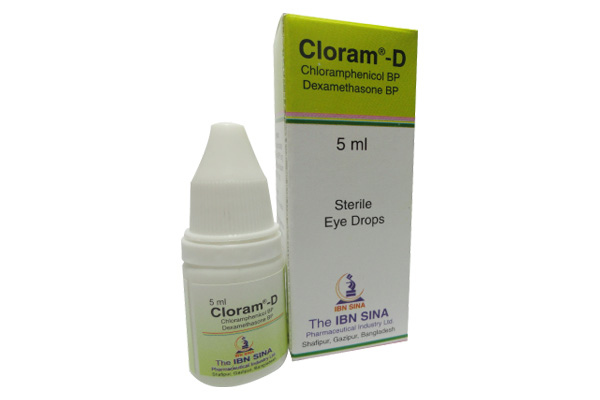
CLORAM D
CHLORAMPHENICOL BP + DEXAMETHASONE SODIUM PHOSPHATE BP
| NAME | STRENGTH | PACK SIZE | DOSAGE FORM |
|---|---|---|---|
| CLORAM D 0.5% W/V + 0.1% W/V | 0.5% W/V + 0.1% W/V | 5 ML | EYE DROP |
Cloram-D sterile eye drops: Each ml solution contains Chloramphenicol BP 5mg and Dexamethasone Sodium Phosphate 1 mg
Chloramphenicol is a true broad spectrum antibiotic. It is active against a wide range of gram-positive and gram-negative bacteria, many anaerobic bacteria, chlamydia and rickettsia. It is usually bacteriostatic but may be bactericidal in high concentrations. Antibiotic activity appears to result from inhibition of protein synthesis of bacterial cells. Chloramphenicol binds to the 50s subunit of bacterial ribosomes, which inhibits peptide bond formation. The protein synthesis of rapidly proliferating cells may be affected, especially mammalian erythrocytes, explaining the mechanism of reversible bone marrow depression. Dexamethasone is one of the most potent corticosteroids; it is 5-14 times more potent than Prednisolone and 25 - 75 times more potent than Cortisone and Hydrocortisone. A paramount importance with regard to local therapy is the fact that Dexamethasone is over 2000 times more soluble than Hydrocortisone or Prednisolonc. Like all other glucocorticoids, Dexamethasone inhibits phospholypase A,, the first step in prostaglandin synthesis. Also, Dexamethasone inhibits the chcmotactic infiltration by inhibiting endothelial expression of adhesion molecules for neutrophils.
Acute and chronic keratitis and conjunctivitis of an infectious, allergic but non-viral nature. Infections of the anterior uvea (iritis, iridocyclitis), scleritis, episclcritis, myositis and sympathetic ophthalmia. Post operative management of glaucoma, cataract and strabismus.
One drop, 1 to 4 times daily, into the lower eyelid of the infected eye’s. Acute cases- Up to 1 drop every hour into the infected eye's.
Hypersensitivity to the ingredients. Injuries and ulcerous process of the cornea, herpes simplex and other viral infected conditions, glaucoma, mycoses, severe blood disorder due to bone marrow depression and hepatic dysfunctions.
The patient should be referred to an ophthalmologist if the eye has not responded within 48 hours. If a rise of intra-ocular pressure occurs, the treatment has to be discontinued.
The local use of Dexamethasone over a prolonged period may lead, in some cases, to secondary glaucoma and development of complicated cataract. To be used, therefore, under strict medical supervision. Because of the possibility of inducing comeal abscess, fungal kcratopathy or glaucoma
There are no adequate and well-controlled studies in pregnant women. This drug should be used during pregnancy only if the potential benefit justifies the potential risk to the fetus. Caution should be exercised when Chloramphenicol and Dexamethasone ophthalmic solution is administered to a nursing mother.
No information provided.
No information available.
Store in a refrigerator at 2° - 8°C temperature. Discard the dropper bottle 30 days alter first opening. Keep out of reach of children.
Each Plastic dropper bottle contains 5 ml sterile eye drops.
